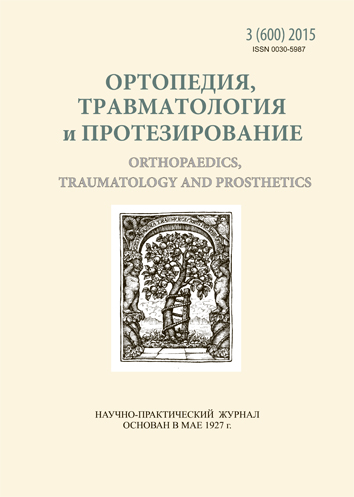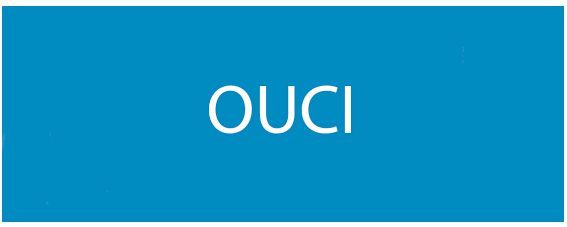Morphological features of healing in experimental cortical layer defect of long bone upon condition of β-tricalcium phosphate implantation
DOI:
https://doi.org/10.15674/0030-59872015346-51Keywords:
ChronOS ™, β-tricalcium phosphate, reparative osteogenesisAbstract
Objective: To compare the healing process in the defect of compact bone tissue after implantation of osteoplastic material ChronOS ™ with restoration of unfilled defect.
Methods: An experiment was conducted on 24 white male rats. In the middle third of the femoral shaft we created hole defect with 2.5 mm diameter toward the medullary canal, and we left it unfilled (control, group I) or filled with osteoplastic material ChronOS ™ (group II). Fragments of injured bones were examined after 15 and 30 days by means of methods of light microscopy with morphometry and scanning electron microscopy.
Results: It was found that the material ChronOS ™ did not induce any inflammatory response, and in the implantation area adjacent to the maternal bone there were gaps with typical osteocytes, and in micropores of ChronOs ™ - osteogenic cells with small foci of osteogenesis suggesting the biocompatibility and osteotropism of this material. In all terms of observation there were revealed some signs of just desmal osteogenesis which indicates the presence in defects of bone and connective tissue in both groups of the animals on. Bone tissue of regenerate in the control group presented with large and small loop meshwork of trabecular bone. In group II animals the newly formed bone tissue repeated the shape of pores of the implant has and contained a large amount of osteoblasts and osteocytes. On the 30th day in defects of animals of both groups we found areas of bone tissue approaching in structure to maternal bone. Material ChronOs ™ subjected to resorption and replaced by bone and connective tissues. Their relationship on the 15th day of the experiment was (39,75 ± 2,85) / (41,1 ± 1,87) / (19,14 ± 1,2)%, on the 30th day - (26,67 ± 1,15) / (54,53 ± 2,6) / (18,8 ± 0,8)%.
References
- Arsenyev I. H. Experimentally-morphological study of clinical application of degradable bio-implants in treatment of fractures and false joints of long bones: Dis .... candidate of medical sciences: 14.00.22, 14.00.15 / Igor H. Arseniev. — Moscow, 2007. — 200 p.
- Grigorian A. S. Problems of integration of implants in bone tissue (theoretical aspects) / A. S. Grigorian, A. K. Toporkova. — Moscow.: Technosphere, 2007. — 128 p.
- Lapach S. N. Statistical methods in biomedical research using Excel / S. N. Lapach, A. V. Hubenko, P. N. Babich. — Kiev: Morion, 2000. — 320 p.
- Paraskevich V.L. Dental implantology: Fundamentals of Theory and Practice / V. L. Paraskevich. — 3rd Ed. — M .: LLC "Medical News Agency", 2011. — 400 p.
- Sarkisov D. S. The microscopic technique / D. S. Sarkisov, Y. L. Perov. — Moscow.: Medicine, 1996. — 542 p.
- Behaviour of ChronOs™ inject in metaphyseal bone de¬fects of distal radius fractures: tissue reaction after 6–15 months / R. Arora, S. Milz, C. Sprecher [et. al.] // Injury. — 2012. — Vol. 43 (10) — P. 1683–1688, doi: 10.1016/j.injury.2012.06.006.
- β-Tricalcium phosphate as a bone substitute for-dorsal spinal fusion in adolescent idiopathic scoliosis — preliminary result of a prospective clinical study / M. Muschik, R. Ludwig, S. Halbhubner [et al.] // Eur. Spine J. — 2001. — Vol. 10 (2). — P. 178–184.
- β-TCP bone graft substitutes in a bilateral rabbit tibial defect model / W. R. Walsh, F. Vizesi, D. Michael [et al.] // Bioma¬terials. — 2008. — Vol. 29 (3). — P. 266–271.
- Pochon J. P. knochenersatzplastiken mit tricalciumphosphatkeramik im kindesalter / J. P. Pochon // Aktuelle Probleme in Chirurgie und Orthopadie. — 1990. — Vol. 36. — P. 146.
- Porous tricalcium phosphate and transforming growth factor used for anterior spine surgery / T. Steffen, T. Stoll, T. Arvinte, R. K. Schenk // Eur. Spine J. — 2001. — Vol. 10 (Suppl. 2). — P. S132–S140.
- Stoll T. New aspects in osteoinduction / T. Stoll // Mat.-wiss. U. Werkstofftech. — 2004. — Vol. 35 (4). — P. 198–202.
- Tricalcium phosphate granules or rigid wedge preforms in open wedge high tibial osteotomy: a radiological study with a new evaluation system / W. L. van Hemert, K. Willems, P. G. Anderson [et al.] // Knee. — 2004. — Vol. 11 (6). — P. 451–456.
- Wheeler D. Grafting of massive tibial subchondral bone defects in a caprine model using — tricalcium phosphate versus autograft / D. Wheeler // J. Orthop. Trauma. — 2005. — Vol. 19 (2). — P. 85–91.
Downloads
How to Cite
Issue
Section
License
Copyright (c) 2015 Olexiy Korenkov

This work is licensed under a Creative Commons Attribution 4.0 International License.
The authors retain the right of authorship of their manuscript and pass the journal the right of the first publication of this article, which automatically become available from the date of publication under the terms of Creative Commons Attribution License, which allows others to freely distribute the published manuscript with mandatory linking to authors of the original research and the first publication of this one in this journal.
Authors have the right to enter into a separate supplemental agreement on the additional non-exclusive distribution of manuscript in the form in which it was published by the journal (i.e. to put work in electronic storage of an institution or publish as a part of the book) while maintaining the reference to the first publication of the manuscript in this journal.
The editorial policy of the journal allows authors and encourages manuscript accommodation online (i.e. in storage of an institution or on the personal websites) as before submission of the manuscript to the editorial office, and during its editorial processing because it contributes to productive scientific discussion and positively affects the efficiency and dynamics of the published manuscript citation (see The Effect of Open Access).














